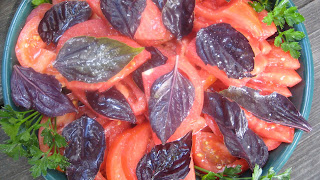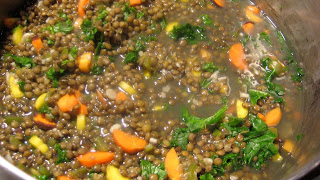






Sorry that the last two Fridays I didn't post. Long story, but had a big bad flare of arthritis on my left knuckle. Hands are still weak and sore so I won't write much today.
I do want to tell this story though. I don't have children, my small family lives downstate, and Bill and I live a somewhat isolated life--me a writer and him an artist. I sometimes I feel at a loss for family connections so the Meadowlark community means a lot to me. Jenny told me this story (it's as I remember it...) a few weeks back and it stayed with me. It's about how important are our connections to one another. Maybe more than food...
This September, Jenny and Ella drove out from the farm on Ella's first day at West Junior High (after being home-schooled since elementary school). All the dear faces of everyone who makes the farm possible--I can't name them all--passed by as Ella and Jenny drove out. They waved and wished her well. Ella looked at her mother and said, "They're all my family too aren't they?"
It's this wider, luxurious scope of "family" that I've learned here in northern Michigan (for almost 35 years!). My Eastern European born parents and relatives trusted only the family tribe. They were suspect of the "other". It breaks my heart open to think that Ella has had the opportunity to learn, on her own, to trust the people and the world around her. Maybe each generation will lean more and more towards trust. Sigh. We need it.
I like to think that little pieces of each of us, and huge pieces of her mom, dad, brother and family, have helped to build the courage that it took for Ella to break out into her new complicated life.
Many hugs to our Meadowlark for her great food and you, the larger community for supporting her.
Here are highlights of the food in photos and recipes from today and the past two weeks. See you next year!
Briami--a Greek dish of oven-braise-roasted vegetable melange with lots of olive oil and fresh herbs tossed on at the end.
Mary is holding the pan of it. Sometimes it's layered with sliced vegetables instead of tossed diced vegetables.
Turkish yogurt soup with mint yuzune (infusion into clarified butter)
Beet tzatziki (see recipe)
Turkish "sigara" filled with feta, scallions and dill, rolled in a 4-1/2 inch by 12 inch strip of phyllo without fat then fried in olive oil.
Pierogi made with same filling--we had leftover. Plus we filled some leftover dough with apples.
Turkish vegetarian kofte wrapped in lettuce leaf--big hit around the farm. (See recipe.)
Nancy's favorite coleslaw (see "recipe")
Technique: Yogurt-Cucumber-Garlic Salad/Sauce
Serve Greek tzatziki as a sauce or dip with toasted pita, with grilled or fried fish or chicken, or with boiled, sliced beets, fried eggplant or zucchini. Turkish cacik is tzatziki’s diluted cousin.
©2010 Nancy Krcek Allen
2 cups, 4 to 6 servings
16 ounces plain Greek or whole milk yogurt, 2 cups
12 to 14 ounce English cucumber, 1 cup packed peeled, seeded and grated
2 cloves garlic, peeled
Juice of 1/2 lemon (2 tablespoons), more to taste
or 2 tablespoons red wine vinegar, more to taste
2 to 3 tablespoons chopped fresh dill, mint leaves or Italian parsley
or 1 tablespoon each: chopped dill, mint and parsley
1 to 2 tablespoons olive oil
1. Prepare yogurt: Line a strainer with dampened cheesecloth and set it over a bowl. Pour yogurt, preferably whole milk, into it and refrigerate 1 to 2 hours—it should reduce volume by half. Drink or discard watery whey. (Whey is full of beneficial bacteria.)
2. Prepare cucumber: peel, seed and grate cucumber. Squeeze grated cucumber and drain. One and 1/2 pounds cucumber yields about 2 cups squeeze-drained grated cucumber.
3. Prepare garlic: mince garlic until pasty with salt to soften its flavor.
4. Combine yogurt, cucumber and garlic. Stir in vinegar or lemon juice, herbs and olive oil. Taste tzatziki and season with salt to taste.
5. Chill 1 hour to blend flavors. Taste again and re-season.
6. Place mixture in serving bowl. Garnish with a drizzle of olive oil if desired.
Vary! Improvise!
*Greek Beet Tzatziki
Boil 1/2 pound beets until tender. Cool. Peel and grate or finely dice beets (yield about 1 cup) and mix with 1 cup drained yogurt, 2 cloves minced garlic, 1/2 cup chopped Italian parsley, 1/4 cup chopped dill, 2 tablespoons fresh lemon juice and salt and pepper.
Technique: Turkish Red Lentil and Bulgar Kofte (Mercimek Köftesi)
This vegetarian favorite is often served rolled into lettuce leaves. It’s the perfect canvas for a host of flavors—the only constants are lentils and bulgar. The kofte will firm as they cool. The flavors are best after 1 to 2 hours or overnight.
©2010 Nancy Krcek Allen
Makes 5 cups, about 30 (2 tablespoons plus 1 teaspoon size) kofte
7 ounces split red lentils, 1 cup
2 tablespoons olive oil, plus more for rolling
8 ounce onion, 2 cups finely, finely diced
2 cloves garlic, 1 tablespoon minced
1 tablespoon Red Pepper Paste (page XX)
or 1 tablespoon tomato paste
or 1 tablespoon chopped sun-dried tomato
5 ounces fine-grain bulgar, 1 cup
Optional: 2 green onions, finely minced
1/2 cup finely chopped Italian parsley
1 lemon, juiced
To serve:
30 small lettuce leaves, whole
Choice of fresh herbs: Italian parsley, mint, cilantro leaves or tarragon leaves
Onion-Sumac Salad, page XX
1. Pour lentils in large saucepan with 3 cups water. Bring to a boil, reduce heat and partially cover pan. Simmer lentils until mushy, 30 minutes. Stir occasionally to keep lentils from sticking to bottom of pot and burning.
2. Heat oil in skillet over medium heat and sweat onion until soft, 5 to 7 minutes. Add garlic and cook 1 minute longer.
3. Stir red pepper paste, onion-garlic mixture and salt into lentils. (Slightly oversalt lentils as they and the bulgar will absorb salt.) Remove saucepan from heat and fold in bulgar and green onions. Set aside 30 minutes to allow bulgar to absorb moisture.
4. Stir in parsley and season mixture to taste with 2 to 3 tablespoons fresh lemon juice, salt and pepper.
5. With oiled hands, place 2 heaping tablespoons of the mixture in the middle of your palm. Squeeze lightly into an elongated oval (like an eye) while you smooth the outer surface.
6. Arrange each kofte on top of its own lettuce leaf and arrange in a sun-ray pattern on a large serving platter. Garnish each kofte with herb leaves.
7. Serve kofte with onion-sumac salad. Eat kofte rolled up with herbs.
Vary! Improvise!
*What spices might you incorporate into kofte? Toasted and ground cumin seed? Coriander? Nigella? Curry powder?
*Cook 2 to 3 tablespoons grated carrot with onions and garlic.
*Fold 1 tablespoon tahini or 2 tablespoons finely chopped walnuts into lentil-bulgar mixture.
*Roll kofte in ground nuts.
Nancy's Red Cabbage Coleslaw
Use any type of cabbage, but red cabbage gives the most eye appeal!
1 head red cabbage, washed, drained and blotted dry
Kosher or sea salt
Red wine vinegar, preferable Eden
Extra virgin olive oil
Options: Italian parsley, cilantro, shredded carrots, caraway seed, chopped walnuts or toasted pine nuts
Quarter cabbage and remove core. Cut into chunks that fit into your food processor tube for grating. Shred cabbage.
Toss cabbage with salt, vinegar and olive oil to taste. Rest cabbage 1 hour. Toss again and re-season. This coleslaw should be highly seasoned, lots of contrast. If it doesn't call you for more bites add more salt, oil and vinegar until it does!

















































